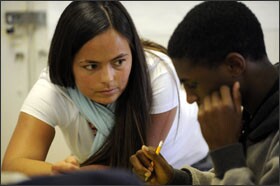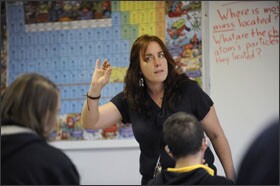The formal lesson in Crystal Darensbourg’s senior English class at the former Shawnee High School one recent morning was about distinguishing personal narratives, personal essays, and memoirs, but a life lesson was also in store for her students.
The assignment: Students had to write about a fear and their efforts to overcome it.
They shared everything from a phobia of chain saws to one of letting down their families, but one stopped the class in its tracks. A student tearfully told classmates she was afraid she wouldn’t be able to go to college. Figuring out the applications, essays, and scholarships was proving to be overwhelming.
“How many of you have that same fear?” Ms. Darensbourg asked. Two-thirds of the hands in the classroom shot up.
“You’re not alone. You have a good support group in this classroom,” Ms. Darensbourg said. “You are going to be absolutely OK. I promise.”
The students aren’t the only ones who need the support this year.
Ms. Darensbourg and the other teachers at the West Louisville high school, now named The Academy @ Shawnee, have a daunting task: reversing the fortunes of one of Kentucky’s lowest-performing schools. The school is one of 10 identified last spring as the worst-performing in the state and now is undergoing a state-mandated restructuring.
Hanging in the balance are the futures of not only Shawnee’s nearly 500 students, but also that of Principal Keith F. Look, who could lose his job if the school doesn’t meet state improvement targets.
Across the country, thousands of educators face the same pressure in helping to fulfill U.S. Secretary of Education Arne Duncan’s $3.5 billion mandate to fix the nation’s most chronically underperforming schools during the next three years. (“Turnaround Team Scrambles at Ky. High School,” Aug. 11, 2010.)
Nowhere to Go But Up
At Shawnee, signs of hope already have surfaced. The first quarterly report submitted to the state early this month showed Shawnee’s students beating the state’s targets for the school’s performance on benchmark assessments taken in September.
But testing data also reflect how low the school’s scores had fallen before the turnaround began: Just 4.7 percent of Shawnee’s students scored “proficient” or higher in math in spring 2010.

“This one knocked me off my seat,” Mr. Look told the faculty during a meeting last month where he discussed the scores with his teaching staff, half of whom arrived here this year as part of the turnaround effort. The reading scores were not much better. Less than a quarter—22.6 percent of students—scored proficient or better.
Mr. Look told the teachers he was certain of one thing: Shawnee will not be at the bottom again.
In its quest to turn around Shawnee, the faculty has emphasized both the academic and the personal. Showing students that teachers are passionate has been crucial to motivating teenagers who might otherwise balk at the increased pace of learning.
“Our goal is to make sure every student can learn in an environment that is caring, patient, and structured,” said Dion S. von Allmen the school’s mathematics department chairman. “The large majority of students want to learn. When you approach them, you have to have a caring and patient attitude at all times. For many students, school is the one place they have someone who is patient and caring.”
Pamela Dixon, the building’s instructional coordinator, is new to Shawnee like Mr. von Allmen. She said getting students used to a building full of teachers with stepped-up expectations has taken time.
“We were asking them to do new and different things,” Ms. Dixon said. “I can see where the students are finally exhaling and saying, ‘This is not so bad after all.’ ”
Slowly but surely, students are making the shift, teachers said.
Science teacher Imogen Herrick said she’s seen a big change in the 10th graders who walk into her room every day. Last year, their attendance was low, but this year, sophomores are leading the building in attendance.
“They really recognize they are having success in school, so they are coming, and coming regularly,” Ms. Herrick said. “To me, that says kids are wanting to come to school.”
The students, especially the senior class, were resistant to the cultural changes when they came back this year. But that softened as the school year progressed, Ms. Darensbourg said. “When they saw in every classroom the expectations are the same, they started to respond to that.”
The school this year also is emphasizing literacy across the building, with students reading novels in chemistry classes and grammar tips appearing on the walls even in algebra classrooms.
With 13 years in Shawnee under his belt, Will VanderMeer, the school’s magnet coordinator, is one of the few veterans left. Mr. Look, who came to the school in 2008, is the fourth Shawnee principal in that span of time.
“We’ve had a lot of good teachers over the years, but we didn’t have that network supporting them,” Mr. VanderMeer said.
“We have the opportunity, with Dr. Look’s vision and all the restructuring, to put the pieces together. The real challenge is to break down the walls so teachers don’t feel like they are toiling by themselves.”
Many Moving Parts
Mr. Look says communication and relationships are key with teachers as well as students. That’s no easy task when he has so many staff members that he’s run out of mailboxes.
He’s focused much of his effort this fall on knitting together the various moving parts of the school, checking in with teachers to make sure they have enough resources, meeting weekly with a turnaround team, and overseeing the construction of a Challenger learning center, to which elementary and middle school children from across the city will travel in order to participate in a high-tech space flight simulation.
With staff members in the building on any given day that report to him, the school district, or the state education department, it can be unclear where authority truly lies.

As part of the turnaround effort, a trio of staff members assigned by the Kentucky education department work with the staff at Shawnee daily. Titled “educational recovery specialists,” Billie Travis and Bill Philbeck work with mathematics and literacy teachers, respectively, while Leesa Moman, the educational recovery leader, also works with Mr. Look and his administrative team, as well as on special education issues. A state audit of the school last winter found that it lacked a formal process for analyzing data, and the state group is helping the school build such a process.
A “data wall” in an area only visible to teachers now holds note cards with the faces and test scores of every Shawnee student, a “big help,” Mr. Look says.
“It changes data when you put a face on it,” Ms. Herrick, the science teacher, said.
‘Name and Claim’
The team spends three to four hours a day in classrooms or meetings with department staff. Team members also submit a weekly report of concerns and accomplishments to their state bosses.
“We have a lot of willing teachers here who see the need for the school to change, and they are working hard,” Ms. Travis said.
At a recent meeting with 9th grade teachers, Ms. Travis and Mr. Philbeck discussed a list of students who were failing three or more of six courses in the first six weeks of school.
As part of a “name and claim” intervention, teachers across the building have each taken on two or three failing students on whom to focus extra attention.
During the second six-week period, 10th grade teachers, for example, will make two phone calls to students’ homes and make two other interventions with the students, based on the data and conversations with the student.
“I’ve found it to be real positive,” Ms. Herrick said. “They don’t want to fail. They don’t think anyone cares. The second someone is at their backs, they turn around and try.”
With so many efforts under way, Mr. Look said he’s found pacing to be a priority.
“Part of my job right now is keeping folks from applying too much pressure to themselves to move things too fast,” he said. “I have teachers in this place who want so badly to do miraculous things that I have to control that ... pacing so that they are just as effective or more in October, in January, and in March and in May.”
Another thing administrators are keeping an eye on is student burnout, said Diane Baker, the school’s special education coordinator. Approximately 25 percent of Shawnee’s population are students with disabilities.
“We can’t move at such a pace that we leave the kids behind,” she said. “We’ve got to step up the pace of curriculum and instruction, but we also have to step up the pace of student learning.” Teachers are trying to keep that balance by pulling students aside for extra help if they don’t master concepts.
Like Ms. Baker, Ms. Darensbourg is optimistic about the results.
“That [sense of] community is back in this building,” she said. “Each department wants to work with other departments. That’s been the missing key for the last few years.”





